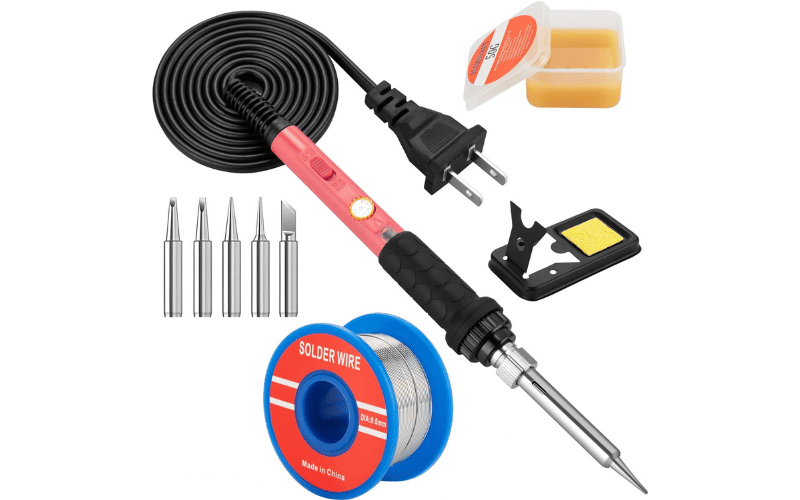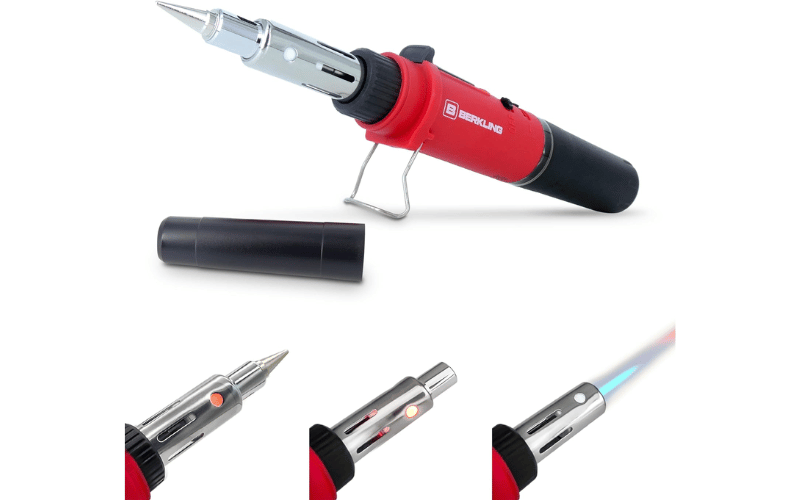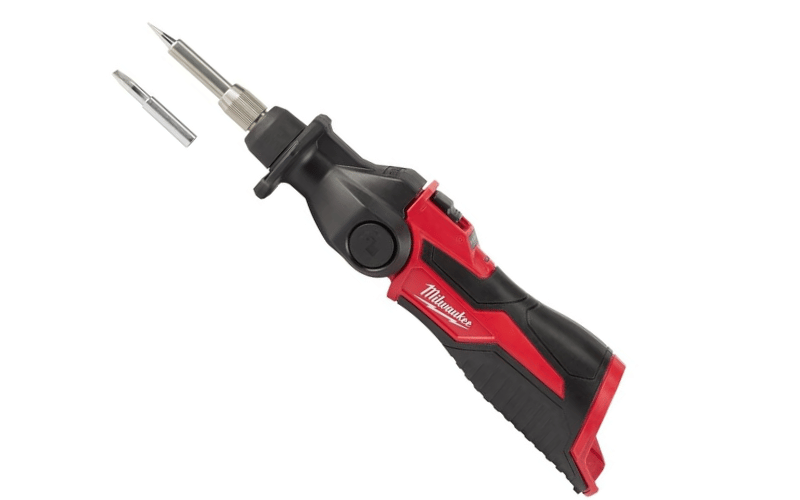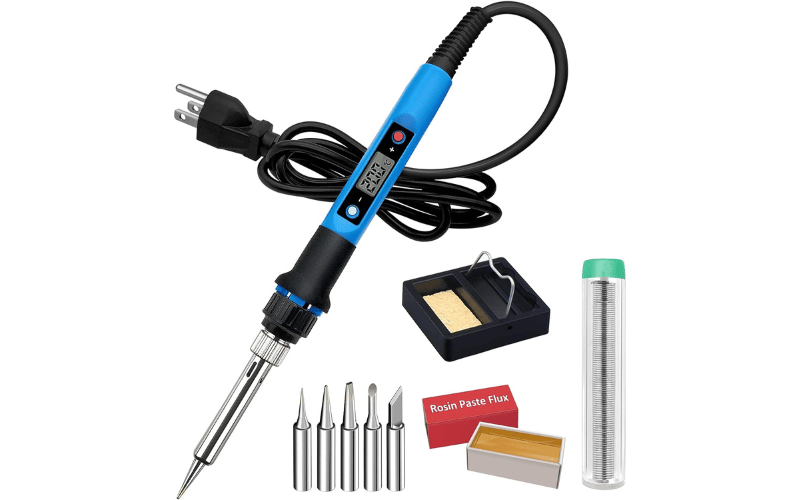Types of Soldering Irons: A Comprehensive Overview
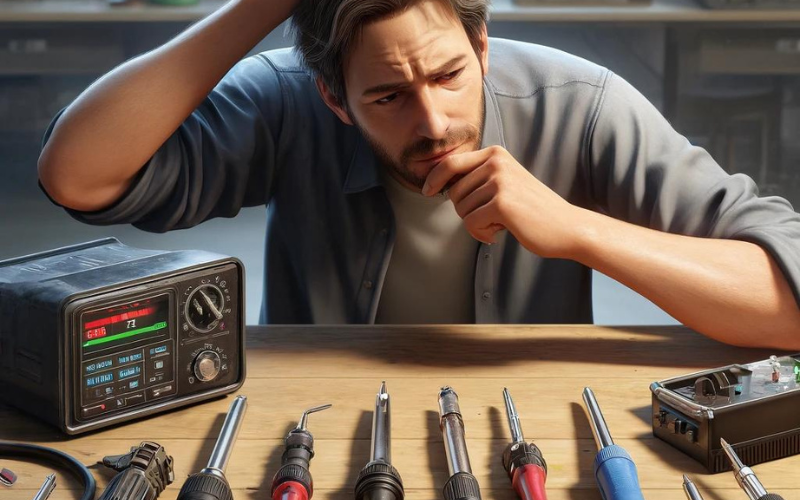
Types of Soldering Irons: A Comprehensive Guide
Introduction
This guide covers various types of soldering irons, their features, applications, and tips for selecting the right one. Whether you are a beginner or a professional, understanding these tools is crucial for achieving precise and reliable solder joints in your projects.
Types of Soldering Irons
1. Soldering Iron Basics
Before delving into the specific types of soldering irons, let’s start with the basics.
- What is a soldering iron?
A soldering iron is a hand-held tool used to heat solder, a metal alloy with a low melting point, in order to join or bond two workpieces together. It is an essential tool for any DIY enthusiast, hobbyist, or professional in the fields of electronics, jewelry making, plumbing, and more.
- Why are soldering irons used?
Soldering irons are used to create strong and permanent bonds between two workpieces. This is achieved by heating the solder to its melting point and then applying it to the joint, where it cools and solidifies, creating a strong and conductive connection. Soldering is commonly used in electronics to connect components on a circuit board, but it can also be used in other applications such as jewelry making, plumbing, and automotive repairs.
- Different components of a soldering iron
A soldering iron typically consists of a heated metal tip, an insulated handle, and a power cord. The metal tip is usually made of copper or iron and is heated by an internal heating element. The handle is designed to be heat-resistant and provide a comfortable grip for the user. Some soldering irons also come with additional features such as temperature control, interchangeable tips, and LED lights for better visibility.
Now that we have covered the basics of soldering irons, let’s take a closer look at the different types available.
2. Types of Soldering Irons
Soldering irons are essential tools for any DIY enthusiast or professional technician. They are used to join two pieces of metal together by melting a filler metal, known as solder, between them. There are several types of soldering irons available on the market, each designed to cater to different soldering requirements. In this section, we will discuss the different types of soldering irons and their unique features and benefits.
- Electric Soldering Irons
Electric soldering irons are the most commonly used type of soldering iron. They are powered by electricity and come in a variety of wattages, ranging from 15 watts to 100 watts. The higher the wattage, the more heat the soldering iron can produce. Electric soldering irons are suitable for a wide range of soldering tasks, from basic electronics repairs to larger projects.
Some electric soldering irons come with interchangeable tips, allowing you to switch between different tip sizes and shapes depending on your project’s needs. They also come with temperature control options, allowing you to adjust the heat according to the type of solder you are using.
- Butane Soldering Irons
Butane soldering irons are portable and do not require an electrical outlet to function. They are powered by butane gas, which is stored in a refillable tank within the soldering iron. These types of soldering irons are ideal for on-the-go soldering tasks, such as outdoor repairs or projects in remote locations.
Butane soldering irons are also versatile, as they can be used as a soldering iron, a hot air gun, or a torch. They come with interchangeable tips and adjustable temperature control, making them suitable for a variety of soldering applications.
- Cordless Battery Soldering Irons
Cordless soldering irons are similar to butane soldering irons in that they do not require an electrical outlet to function. However, instead of using butane gas, they are powered by rechargeable batteries. These types of soldering irons are convenient for small soldering tasks or for working in tight spaces where a corded soldering iron would be difficult to maneuver.
Cordless soldering irons come with interchangeable tips and adjustable temperature control, making them suitable for a variety of soldering applications. They are also lightweight and portable, making them a popular choice among DIY enthusiasts.
- Temperature-Controlled Soldering Irons
Temperature-controlled soldering irons are designed for more precise and delicate soldering tasks. They come with a built-in temperature control feature, allowing you to set and maintain a specific temperature throughout your soldering project. This is especially useful when working with sensitive electronic components that require a specific temperature to avoid damage.
Temperature-controlled soldering irons come in both electric and butane-powered options and are available in a wide range of wattages. They are also suitable for a variety of soldering applications, from electronics repairs to jewelry making.
- Soldering Stations
Soldering stations are a combination of a soldering iron and a temperature-controlled base. They are ideal for professional technicians or those who frequently work on complex soldering projects. Soldering stations come with a variety of features, such as adjustable temperature control, interchangeable tips, and digital displays for precise temperature readings.
They also come with additional accessories, such as a sponge for cleaning the soldering iron tip and a stand for holding the soldering iron when not in use. Soldering stations are more expensive than other types of soldering irons, but they offer more control and precision, making them a worthwhile investment for serious soldering work.
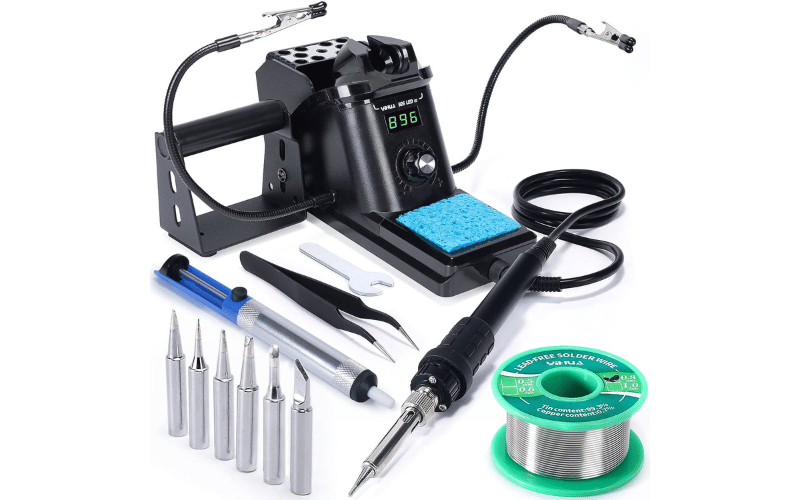
Summary Table for Types of Soldering Irons
| Type of Soldering Iron | Pros | Cons | Price Range | Ideal Applications |
|---|---|---|---|---|
| Electric Soldering Irons | Common, variety of wattages, interchangeable tips, temperature control | Requires power outlet, less portable | $10 – $100 | General electronics, DIY projects, household repairs |
| Butane Soldering Irons | Portable, versatile (can be a torch or hot air gun), refillable tank | Requires butane refills, can be less precise | $20 – $80 | Fieldwork, automotive repairs, outdoor projects |
| Cordless Battery Soldering Irons | Portable, rechargeable batteries, interchangeable tips | Limited battery life, less power compared to corded models | $20 – $50 | Quick fixes, small projects, on-the-go repairs |
| Temperature-Controlled Irons | Precise temperature control, suitable for delicate tasks | Can be more expensive, requires power source | $30 – $150 | Sensitive electronics, professional-grade soldering |
| Soldering Stations | High control, precision, includes accessories like sponges and stands | Bulkier, more expensive | $50 – $300 | Extensive soldering work, production lines, laboratories |
3. Choosing the Right Soldering Iron
When it comes to selecting the right soldering iron, there are a few key factors to consider. These include wattage, temperature control, portability, specialized applications, and budget. By carefully evaluating these factors, you can choose a soldering iron that best suits your needs and achieve successful results in your projects.
Choosing the right soldering iron is crucial for achieving successful results in your projects. With so many options available in the market, it can be overwhelming to make a decision. However, by understanding the different types of soldering irons and their features, you can make an informed choice that meets your specific needs.
- Wattage Requirement
One of the first things to consider when choosing a soldering iron is its wattage and power requirements. The wattage of a soldering iron determines its heating capacity and how quickly it can melt solder. For general soldering tasks, a soldering iron with a wattage between 20-40 watts is sufficient. However, for more complex projects or larger components, a higher wattage may be necessary.
Additionally, it is important to consider the power requirements of the soldering iron. Some models may require a higher voltage or specific power source, which may not be readily available in your workspace. It is important to check the power requirements before making a purchase to ensure compatibility.
- Power Requirement
Temperature control is another important factor to consider when choosing a soldering iron. Some models come with a fixed temperature setting, while others offer adjustable temperature control. For delicate components or specialized soldering tasks, it is recommended to opt for a soldering iron with temperature control to prevent overheating and damage.
There are also soldering irons with digital temperature displays, allowing for precise temperature adjustments. These are ideal for more advanced projects that require specific temperature settings.
- Portability
Depending on your workspace and the nature of your projects, portability and ease of use may be important factors to consider. If you need to move around frequently or work in tight spaces, a cordless or butane soldering iron may be a better option. These models offer more flexibility and mobility compared to traditional electric soldering irons.
Additionally, consider the weight and grip of the soldering iron. A comfortable and ergonomic design can make a significant difference in your soldering experience, especially for longer projects.
- Flexibility
If you have specific soldering needs, such as working with small or delicate components, it is important to choose a soldering iron that is suitable for these specialized applications. Some models come with interchangeable tips or attachments for different soldering tasks, while others are designed specifically for certain types of soldering, such as surface mount technology (SMT) or through-hole soldering.
- Budget
It is important to assess your soldering needs and choose a soldering iron that can handle the tasks you require.
Last but not least, budget is an important factor to consider when choosing a soldering iron. While it may be tempting to opt for a cheaper model, it is important to remember that quality and features may be compromised. It is recommended to invest in a good quality soldering iron that meets your needs and will last longer, rather than constantly replacing cheaper models.
However, if you are a beginner or have limited soldering needs, a budget-friendly soldering iron may be a suitable option.
By carefully considering these factors, you can choose the right soldering iron that meets your specific needs and budget. Remember to also read reviews and compare different models to make an informed decision. With the right soldering iron, you can achieve successful results in your projects and improve your soldering skills.
Tips for Soldering Success
1. Preparing for Soldering
- Cleaning and Tinning the Soldering Tip
- Before beginning any soldering project, it is important to properly clean and tin your soldering tip. This helps to ensure a clean and efficient transfer of heat to the solder and the components being soldered. To clean the tip, use a damp sponge or brass wire cleaner to remove any residue or oxidation. Once the tip is clean, apply a small amount of solder to the tip to create a thin layer of fresh solder. This process is known as tinning and helps to protect the tip from oxidation and improve heat transfer.
- Choosing the Right Solder
- Choosing the right solder for your project is crucial for achieving successful solder joints. There are various types of solder available, including lead-based and lead-free options. It is important to choose a solder with a melting point appropriate for the components being soldered. Additionally, consider the type of flux in the solder, as this can affect the ease of soldering and the cleanliness of the joint.
- Preparing the Work Area
- Before starting any soldering project, it is important to prepare your work area to ensure safety and efficiency. Make sure your work area is well-ventilated to avoid inhaling any fumes from the solder. Keep a fire extinguisher nearby in case of any accidents. It is also helpful to have a soldering mat or heat-resistant surface to protect your work surface from heat damage.
2. Soldering Techniques
- Basic soldering techniques:
- Ensure the soldering iron is at the correct temperature before starting.
- Hold the soldering iron like a pencil, with a comfortable grip.
- Use a helping hand tool or a third hand tool to hold the components in place.
- Apply a small amount of solder to the tip of the iron to help with heat transfer.
- Place the tip of the iron on the joint to be soldered and hold it there for a few seconds to allow the heat to transfer.
- Once the joint is heated, touch the solder to the joint, not the iron, and let it flow onto the joint.
- Remove the solder and the iron, and let the joint cool before moving the components.
- Advanced soldering techniques:
- Use flux to help with the soldering process, especially when working with larger components or difficult-to-solder materials.
- Use a soldering iron with adjustable temperature settings for more precise control.
- Practice on scrap materials before attempting to solder on a project.
- Use a soldering iron with a fine tip for precision work.
- Consider using a soldering station with a built-in fume extractor for better ventilation.
- Tips for soldering precision components:
- Use a magnifying glass or a microscope to see the small components and joints more clearly.
- Use a fine-tipped soldering iron and thin solder for precise soldering.
- Secure the components in place with a helping hand tool or a third hand tool to prevent movement during soldering.
- Be patient and take breaks if needed to avoid mistakes.
Remember, practice makes perfect when it comes to soldering. Don’t be discouraged if your first few attempts are not perfect. With time and practice, you will become more comfortable and skilled at soldering.
3. Troubleshooting and Maintenance
- Identifying Common Soldering Issues:
- Cold joints: This occurs when the solder does not properly flow and adhere to the joint, resulting in a weak connection. This can be caused by not heating the joint enough, using too little flux, or not properly cleaning the joint before soldering.
- Solder bridges: This happens when excess solder connects two adjacent joints, causing a short circuit. This can be avoided by using the correct amount of solder and using a solder wick to remove any excess.
- Burned components: If the soldering iron is too hot or left on a component for too long, it can cause damage to the component. To prevent this, always use the correct temperature for the component and avoid leaving the iron on the component for too long.
- Loose connections: If the solder joint is not strong enough, it can result in a loose connection. This can be caused by not heating the joint enough or not using enough solder. To fix this, reheat the joint and add more solder if needed.
- Proper Soldering Iron Maintenance:
- Clean the tip: It is important to regularly clean the soldering tip to prevent buildup of oxidation and debris. This can be done by wiping the tip with a damp sponge or using a brass wire cleaner.
- Tin the tip: Tinning the tip involves coating it with a thin layer of solder. This helps to improve heat transfer and prevent oxidation. It is recommended to tin the tip before and after each use.
- Replace worn tips: Over time, soldering tips can become worn and lose their effectiveness. It is important to regularly check and replace worn tips to ensure quality soldering.
- Store the iron properly: When not in use, always store the soldering iron in a safe and secure place. This will prevent damage and ensure the iron is ready for use when needed.
- Safety Precautions for Soldering:
- Always wear safety glasses to protect your eyes from any flying debris or solder splatters.
- Work in a well-ventilated area to avoid inhaling any fumes from the solder.
- Keep flammable materials away from the soldering area to prevent any accidents.
- Unplug the soldering iron when not in use to prevent any accidental burns or fires.
- Do not touch the soldering iron tip with your bare hands, always use a heat-resistant tool to handle it.
Conclusion
To ensure the utmost satisfaction in your soldering endeavors, it is imperative to thoughtfully evaluate above key factors in selecting the appropriate soldering iron that aligns with your unique requirements and financial constraints. Additionally, conducting thorough research and comparing various models will aid in making a well-informed decision. With the proper soldering iron, you can confidently achieve exceptional outcomes in your projects and enhance your soldering proficiency.
